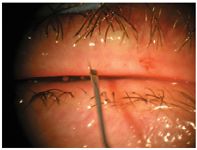Article
Probing procedure eases MGD
Author(s):
A procedure that uses meibomian gland intraductal probing seems to be helpful in patients with severely obstructed meibomian glands.

Key Points


The standard therapy that patients should adhere to daily is lid hygiene, which consists of warm compresses and cleansing with mild soap plus oral tetracycline with the goal of changing the nature of the oil in the glands.
Refined technique
The initial probing procedure, which involves application of anesthetic followed by probing of the glands on the lid with a 1- and 2-mm probe in patients who complain of lid tenderness as well as symptoms excluding lid tenderness such as burning and stinging, was developed by Steven L. Maskin, MD, FACS, in private practice in Tampa, FL. Four- and 6-mm probes also are available as well as microtubes to inject a pharmaceutical.

Based on those results, Dr. Tauber became interested in this technique in order to provide more effective care for his patients with MGD. He has refined some aspects of the treatment to suit his patient population better.
"Patient selection is an important factor," Dr. Tauber said. "Certain procedures work for certain patients."
He performs the probing technique for patients with obstructive MGD, that is, those patients for whom lid compression produces little or no secretion. This differs from Dr. Maskin, who treats these patients but also treats patients with lid tenderness, which Dr. Tauber believes is a rare complaint in the patients he sees.
Another difference between the two surgeons is the extent to which they use the probe, with Dr. Maskin focusing on eliminating lid tenderness by ensuring treatment of tender glands in lid tenderness cases and treating all glands in cases with symptoms excluding lid tenderness, and Dr. Tauber treating all glands.
The biggest drawback to the procedure, Dr. Tauber pointed out, is the patient discomfort resulting from the probing. In light of this, Dr. Tauber refined what he considered to be woefully inadequate anesthesia for use in his practice. He now applies a custom-formulated topical gel preparation of tetracaine and lidocaine prepared by a compounding pharmacy.
Dr. Maskin now uses a topical anesthetic ointment applied to the lid margin of lidocaine 8% and jojoba oil 25%.
The procedure, which Dr. Tauber describes as "well-tolerated by most patients," usually requires about 20 minutes of office time to complete with most patients. The patients experience transient discomfort in varying degrees related to the probing. About 10% to 15% of patients take 5 mg of diazepam before the procedure.
No postoperative medications are required, and there is a low likelihood of postoperative side effects associated with the probing. The only side effects that do occur are related to the anesthesia and eye rubbing, according to Dr. Tauber.
Newsletter
Don’t miss out—get Ophthalmology Times updates on the latest clinical advancements and expert interviews, straight to your inbox.





